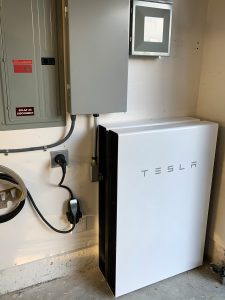 My two Tesla Powerwall 2‘s were installed last week and now I’m running on my own solar-generated power after dark!
My two Tesla Powerwall 2‘s were installed last week and now I’m running on my own solar-generated power after dark!
You see, Powerwalls not only keep the lights on when the power goes out but they also let you automatically time shift energy daily to avoid using power from the grid at peak demand times – not something you get from a traditional backup generator. Plus they don’t need any maintenance or fuel.
And yes, this does mean that now I will still have power for the whole house and, most importantly, running water the next time PG&E needs to shut down the power grid for fire safety. Yay!
Avoiding Peak Demand Usage
It used to be that daily peak energy demand occurred through the mid to late afternoons but with the widespread adoption and installation of solar photovoltaic panels, that afternoon demand has evaporated and the peak demand now comes in the evenings. As a result, power companies have been adjusting their rate schedules to reflect that, with the highest cost of energy running well after dark to 8 and 9 pm.
With battery storage, you not only get backup power for the whole house in the case of outages, but you can also automatically store energy generated during low demand periods of the day (including from your own solar panels) and automatically use that stored energy during the later peak hours, even after the sun goes down. This means that your existing solar PV system ends up being even more effective and cost-efficient.
Time-shifting energy usage with battery storage works so well that Tesla and other companies have been actively deploying massive, utility level battery storage systems around the world, in place of traditional, expensive peaker plants. (Peaker plants are power plants whose primary purpose is to cover periods of high demand.)
Powerwall Configuration Options
I really like the Tesla app for configuring and monitoring your Powerwall and, if present, your solar PV system. It continually displays the flow of power between your home, Powerwalls, solar panels and the power grid – in real time.
You can specify to keep the system in a “backup only” mode (keeping the batteries fully charged at all times), in a “self-powered” mode (where it stores any excess solar generated and uses it to power the home as much as possible each day), or in one of two time-based control modes where it forecasts your future energy usage and time-shifts your energy use and solar production to fit the peak, off-peak and shoulder periods of your particular electricity rate schedule. And all of these modes operate under a “storm watch” feature that will automatically override the normal behavior of the Powerwall to prepare for forecasted storms or other events that may result in an outage. All very cool!
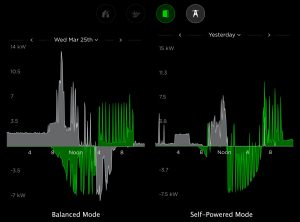
I tried running in the “balanced” time-based mode for most of March but then switched to “self-powered” mode because, during the non-summer months (October – April), there is no peak rate and the difference between partial-peak and non-peak is only a couple of cents. In “balanced” mode, the system would make a point of exporting any excess solar generation during the partial-peak period for credit rather than continuing to charge the Powerwalls. This would mean it would be more likely to need grid power overnight. Now in “self-powered” mode, the Powerwalls are charged more and usually able to handle the entire house load overnight – depending on the weather (solar production and house heating need).
Update (June 2020): Well, it’s not even summer yet and the Powerwalls are already letting the house run completely self-powered most days. And by “house” I mean everything (central heating, water heater, cooktop/oven, washer/dryer, well & pressure pumps, septic system pumps) plus the cars (we’re both driving electric). There were a couple of days that were a bit stormy and cold enough to want to heat the house and a couple days of heavier charging of one of the cars, but every other day required no power from the grid (day or night) – and yet the system still exported plenty of excess solar generation by the end of the day. Having a couple of Powerwalls really does sort of double how much you get out of your existing solar panels. (I’ve got a 9 kW solar system.)
During the summer months, when there’s a daily period of much higher peak pricing, I expected to make use of the time-based “balanced” mode to optimize how much credit I get for excess solar generation. As it turns out, in the “balanced” mode the Powerwalls will switch to exporting solar power during the peak period even if the batteries aren’t yet full. So I switched back to “self-powered” mode to let the batteries fully charge each day to be sure to have plenty for overnight usage. They tend to fill up by early afternoon on sunny days and plenty of excess solar power gets exported at the peak rates anyway. This excess solar generation during the spring to autumn months will still make up for the power I need from the grid over the winter when the house uses much more energy for heating. (My panels were installed to optimize for summer peak rates – 75% of them are oriented to the west for summer afternoons. Now that I have the Powerwalls, I almost wish I had optimized them more for the winter sun.)
If you’re interested in buying a Powerwall, using someone’s referral link will gain you (and the person who referred you) a small rebate. Here’s my Tesla referral link.
Installation Issues
My installation by Tesla wasn’t without issues.
a) Plans vs Reality
To save on installation costs, the initial system design is done based on photographs and information you provide over the phone and via a web site. As such, the Tesla installers arrived with the expectation of installing the Powerwall units outside (rather than in the garage), including my heat pump and car charging circuits as part of the overall house backup and not including the my water pressure pump system due to its expected high initial inrush current requirements.
Well, it was easy enough to get them to switch to placing the Powerwalls inside the garage where they would be subjected to a milder temperature range. And easy to move the car charging circuit so that my Model 3, with three times the capacity as the two Powerwalls (at 26 kWh), won’t inadvertently drain the Powerwalls by charging during an unexpected outage overnight. (I’ve since read that Tesla may develop software changes to coordinate between the Powerwalls and Tesla cars to avoid charging during an outage without having to move any circuits during installation.)
Also, I was surprised to learn (long after the install) that any circuits that are located outside of the backed up panel will still receive power from the Powerwalls when the grid is active. They’re only disconnected from the Powerwalls during a power outage. I see this as unfortunate as I’d prefer to have the car charge only from the grid just to avoid the DC-to-AC conversion overhead and let the house otherwise run entirely on self-generated power most days.
As for including the heat pump in the whole house backup, I don’t mind having it as part of the backup since I don’t run it overnight anyway and can easily disable it during an extended outage to avoid draining the Powerwalls.
b) Water Pressure Pump

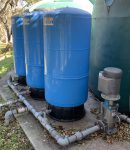 However, my water pressure pump was a problem. Surprisingly, the Tesla technicians and their call-in installation hot line person were not prepared to provide a solution to getting around the inrush current demands of my pressure pump, even though they do “soft start” controller installations for A/C and heat pump systems as needed. They took measurements showing that the momentary, split-second startup inrush on the pump was about 120 amps where two Powerwalls together can handle only up to 56 amps inrush. I had to make arrangements with a local water pump installation company to replace some of my equipment to allow it to “soft start” as well. This entailed replacing my existing single phase 5 hp pump with a three-phase variable speed pump and a constant pressure, soft start controller. Unfortunately it was pretty expensive (nearly $6K, ouch), but running water during an extended, multi-day outage is a definite “really-want-to-have” luxury, particularly as these wide-area, wildfire prevention, PG&E outages become a more common occurrence.
However, my water pressure pump was a problem. Surprisingly, the Tesla technicians and their call-in installation hot line person were not prepared to provide a solution to getting around the inrush current demands of my pressure pump, even though they do “soft start” controller installations for A/C and heat pump systems as needed. They took measurements showing that the momentary, split-second startup inrush on the pump was about 120 amps where two Powerwalls together can handle only up to 56 amps inrush. I had to make arrangements with a local water pump installation company to replace some of my equipment to allow it to “soft start” as well. This entailed replacing my existing single phase 5 hp pump with a three-phase variable speed pump and a constant pressure, soft start controller. Unfortunately it was pretty expensive (nearly $6K, ouch), but running water during an extended, multi-day outage is a definite “really-want-to-have” luxury, particularly as these wide-area, wildfire prevention, PG&E outages become a more common occurrence.
c) Forgotten Heat Pump Soft Start
In the confusion of addressing the above issues, they forgot to install the “soft start” for the heat pump and they apparently miss-reinstalled my original SunPower monitoring CT’s when they had to move them. After I called, the Tesla installers made a return trip to address these issues but things still didn’t go smoothly.
First off, after the soft start installation for the heat pump, we mistakenly thought the heat pump was starting up okay when seeing and hearing the outside fan run but we failed to verify if the compressor was running. Well, it wasn’t. I noticed several hours after they left that I was no longer getting any heat. I tried to make arrangements with the crew directly to come back and fix it, but that never worked out. I had to schedule yet another visit through Tesla Service another week and a half out. In the meantime, I looked up the wiring instructions for the safe start module and examined what they did and it looked to me like the common wire for the compressor was wired to the wrong terminal. I wasn’t willing to try changing it for fear of damaging something but when someone else from Tesla returned, he quickly determined that it had indeed been mis-wired. It is now fixed and working properly.
d) Misplaced Old Usage Monitoring CT’s
 During the installation of the heat pump soft start, they also spent a couple of hours troubleshooting my old SunPower usage monitoring CT’s (current transformers), with my limited help. The issue was that they were no longer properly measuring power usage and instead reporting negative consumption at times when the house was definitely using power. And we spent multiple hours troubleshooting them because, unlike the Tesla monitoring, my SunPower monitoring seems to take 20-40 minutes or more to show new data.
During the installation of the heat pump soft start, they also spent a couple of hours troubleshooting my old SunPower usage monitoring CT’s (current transformers), with my limited help. The issue was that they were no longer properly measuring power usage and instead reporting negative consumption at times when the house was definitely using power. And we spent multiple hours troubleshooting them because, unlike the Tesla monitoring, my SunPower monitoring seems to take 20-40 minutes or more to show new data.
They eventually realized that while the CT’s were indeed installed in the correct orientation on their original visit, the large 200 amp breaker they added to my main subpanel reversed the two phases of power to the panel and that put the power connection for the SunPower-installed “WattNode Modbus” monitoring box out of phase with the CT’s and screwed up the results. Reversing the power leads eventually fixed the SunPower consumption monitoring – except for the fact that my previously installed WattNode box has no way of differentiating between power from the grid or power from the Powerwalls.
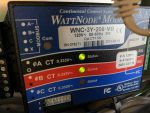 I thought that this would be okay but it actually screws up the SunPower monitoring in such a way that all of my solar production appears to be home consumption since the CT’s are no longer in a position to see how much power is being exported to the grid (or stored by the Powerwalls for that matter). It just appears to be used by the house. So, a few days later, I ended up moving the CT’s myself to the point between the house and the grid where they will at least measure grid import/export correctly. All power in/out of the Powerwalls will be invisible to my old SunPower monitoring. When running on stored power, the house will just look like it’s not consuming anything. This is probably the best that can be expected. And besides, Tesla’s monitoring system shows everything correctly anyway: house consumption, solar production, Powerwall charging/discharging, and grid import/export.
I thought that this would be okay but it actually screws up the SunPower monitoring in such a way that all of my solar production appears to be home consumption since the CT’s are no longer in a position to see how much power is being exported to the grid (or stored by the Powerwalls for that matter). It just appears to be used by the house. So, a few days later, I ended up moving the CT’s myself to the point between the house and the grid where they will at least measure grid import/export correctly. All power in/out of the Powerwalls will be invisible to my old SunPower monitoring. When running on stored power, the house will just look like it’s not consuming anything. This is probably the best that can be expected. And besides, Tesla’s monitoring system shows everything correctly anyway: house consumption, solar production, Powerwall charging/discharging, and grid import/export.
After some more online research, I learned I could order a second set of CT’s to place on my separate, external-to-the-Powerwalls car-charging circuit so that it would still be included in my old Sunpower monitoring. (The WattNode box supports having multiple identical CT’s wired together in parallel in order to add their measured current together.)
e) County Inspection
The other thing that didn’t go smoothly was the county inspection. Santa Cruz County apparently only gives a time window on the morning of, but that wasn’t passed on to me and I wasn’t told there would be a Tesla representative present – and as it turns out they got lost trying to find my place. When the inspector showed up, Tesla wasn’t there and I didn’t have the permits or even know they were coming so he took off again. When I eventually heard from the Tesla guy, he was unable to convince the inspector to come back to the house that day. Tesla rescheduled for another day but a similar mishap occurred and I had to schedule it yet again. Eventually though we got things signed off with the county inspector – and somewhat surprisingly, this was on the day after the county-wide “shelter-in-place” order went into effect due to the coronavirus pandemic. I was half expecting the county to cancel inspections as some other counties did.
So, not a smooth installation process at all. Despite these issues though, the Powerwalls are working great and they’re definitely cool products (hardware and software) and they’re easy to recommend. I should add that buying the Powerwalls direct from Tesla and installed by Tesla was much cheaper than through my local installer. And there are still significant federal tax rebates available for these systems (26% at this time).

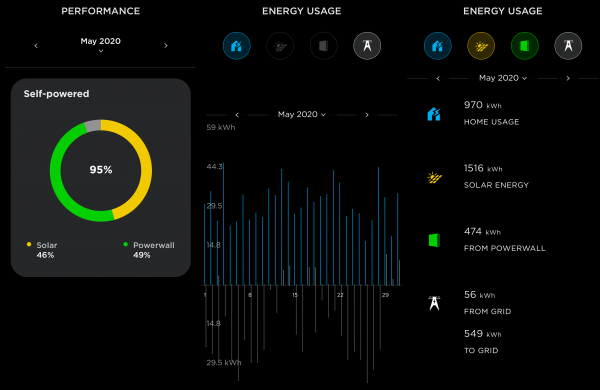
0 comments